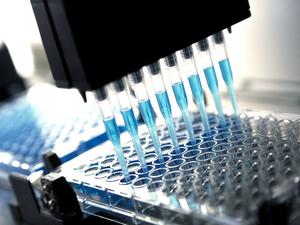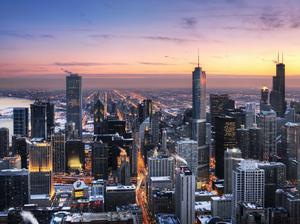Close your eyes and imagine the sounds of a Bulls game. Players' feet pound up and down the court, attendees climb up and down stairs to grab a beer, fans jump out of their seats to cheer when Derrick Rose hits a buzzer beater.
Now imagine if the impact from all those footsteps, stair climbing, and jumping was generating enough power to light up the Jumbotron.
That's the idea behind Touch Light, a startup from University of Illinois Urbana-Champaign, whose tech can generate power from the impact of a footstep. Their product, the Power Pad, is placed below carpets or floorboards, and harnesses energy from the force of a footstep using proprietary compounds that work similarly to piezoelectric materials (more on that in a second).
Initially Swarnav Pujari, the freshman materials science and engineering major behind the tech, is aiming to get Power Pads in office and government buildings, and yes, perhaps one day a stadium. But eventually, his goal is to use Touch Light tech to harness motion in a way that could wean us off our dependency on fossil fuels.
But first step first: the Power Pad.
The proprietary tech works similarly to something called piezoelectric materials, found in electronics such as speakers and gas lighters. When someone applies pressure to a certain crystal or polymer, it induces an electric current. Similarly, when someone steps on a Power Pad, it depresses less than an eighth of an inch, and an inner mechanism turns that force into energy that can be transferred into batteries, a cell phone, the grid, or other places that need power.
Each Power Pad is a square foot. The device currently generates 10 watts of power per step, which Pujari said they should be able to get up to 100 watts with more development and resources. So what exactly could that power? Pujari said if you put 20,000 Power Pads down in Grand Central Terminal in New York City, the average foot traffic would be enough to power all the lights.
This could save commercial office buildings some serious cash on energy bills. Each Power Pad would retail for about $20, but Pujari estimates the average commercial office building (which is about 19,000 square feet) that purchased 2,000 Power Pads would be able to generate enough power to save $80,000 per year in energy bills.
"We have a product that with further development and optimization could be a reliable supplemental source of power initially, which could knock thousands [of dollars] off your bills," he said.
Swarnav has been experimenting with renewable tech since he was 11, and designed a vehicle powered by solar, hydro, and wind power that won a Ford competition was featured in the New York Times. As he headed to high school, he dreamed of playing baseball for University of Connecticut (he's from Westchester, New York), but a life-threatening bout of pancreatitis sidelined him from the field. Instead, pushed by a research requirement in high school, he set up a lab in his basement and started exploring how force could be used as a source of renewable energy.
Here's his reasoning: wind and solar energy are too slow and dependent on the whims of nature (solar isn't as strong on a cloudy day, wind is inconsistent), so why not explore an energy source that can essentially be delivered "on-demand" because we control it?
Through high school, he worked to develop his idea under the tutelage of Purdue University piezoelectric expert Dr. Wenzhuo Wu, won several competitions showcasing his engineering work, and even tested the tech in his high school and at a Knicks event (where fans could light up an LED sign by walking across the tiles). Now he's in the process of developing a market-ready prototype along with his four advisors including Wu; Dr. Paul Braun, professor in materials science and engineering at UIUC; Gary Durack, adjunct professor of bioengineering; and Sushant Pujari (his dad). Next up, he's competing in UIUC's Cozad New Venture Challenge at the end of the month.
We have something that could remove dependence on fossil fuels in a decade's time.
He's not the only one working on this tech: Pavegen, a London-based company, has been implementing similar tech in soccer pitches, music festivals, and office buildings. However, its capacity is much lower (generating seven watts per step) than Pujari's goal with the Power Pad.
Pujari and his family have put about $20,000 into the venture so far, so his next big goal is to raise funding--his goal is $300,000 by the end of the year--to get to get a market prototype up and running. From there, he anticipates demoing through next year, getting pre-orders, and having Power Pads in the market within three years.
After that? He's got some ideas, including roads lined with Power Pads that could power street lights from the weight of cars, and an internal cell phone battery that doesn't die because it gathers energy from your movement. "It doesn't just stop at the Power Pad," Pujari said.
"Our motto is: 'Solving the energy crisis one step at a time,'" he said. "We have something that could remove dependence on fossil fuels in a decade's time."








